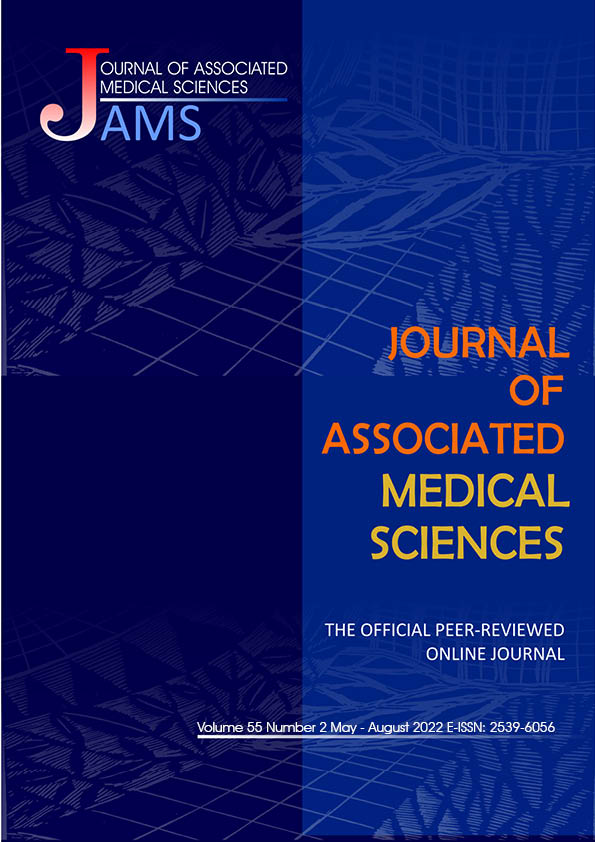The study of postmortem blood gamma-hydroxybutyric acid (GHB) concentrations in Thai dead bodies unrelated to GHB use
Main Article Content
Abstract
Background: Gamma-hydroxybutyric acid (GHB) is classified as a category I psychotropic substance in Thai legislation. It can be exogenously consumed or endogenously produced and cut-off concentrations are required. Baseline GHB concentration ranges in Thai postmortem cases are still not available.
Objectives: To determine baseline GHB concentrations and factors influencing GHB concentrations in Thai postmortem cases.
Materials and methods: Postmortem femoral and cardiac blood samples were collected from Thai cadavers aged 18 years old or older sent for medico-legal autopsies at the Department of Forensic Medicine, Siriraj Hospital, Mahidol University between 18th August 2021 and 25th January 2022 with postmortem interval (PMI) not greater than 24 hours. Case data including sex, age, PMI, sites of collection and causes of death were recorded. Blood GHB concentrations were extracted using protein precipitation and analyzed by gas chromatography-mass spectrometry (GC-MS). Descriptive statistics, paired samples Wilcoxon signed-rank test, Spearman's correlation, Mann-Whitney U test and Kruskal-Wallis H test were analyzed where appropriate.
Results: A total of 150 subjects were recruited; 63 (42%) were female with mean age 44.59 years old (range 18-75 years old). Femoral and cardiac GHB concentration ranges were <0.5-20.81 µg/mL and 1.12-39.04 µg/mL, respectively while median GHB concentrations in femoral and cardiac blood were 6.38 and 8.41 µg/mL. Femoral GHB concentrations were significantly lower than cardiac GHB concentrations (p<0.001). Both femoral and cardiac blood showed a positive correlation between GHB concentrations and PMI (Spearman’s correlation =0.52 and 0.32, p<0.001). Most GHB concentrations in femoral blood were less than 10 µg/mL and almost all samples from both sources had GHB concentrations less than 30 µg/mL.
Conclusion: GHB concentrations in Thai postmortem cases were <0.5-20.81 µg/mL in femoral blood and 1.12-39.04 µg/mL in cardiac blood, respectively. GHB concentrations
in femoral blood were significantly lower than in cardiac blood. GHB concentrations significantly increased with longer PMI.
Article Details

This work is licensed under a Creative Commons Attribution-NonCommercial-NoDerivatives 4.0 International License.
Personal views expressed by the contributors in their articles are not necessarily those of the Journal of Associated Medical Sciences, Faculty of Associated Medical Sciences, Chiang Mai University.
References
. Busardò FP, Jones AW. GHB pharmacology and toxicology: acute intoxication, concentrations in blood and urine in forensic cases and treatment of the withdrawal syndrome. Curr Neuropharmacol. 2015; 13(1): 47-70. doi: 10.2174/1570159X13666141210215423.
. Brailsford AD, Cowan DA, Kicman AT. Pharmacokinetic properties of γ-hydroxybutyrate (GHB) in whole blood, serum, and urine. J Anal Toxicol. 2012; 36(2): 88-95. doi: 10.1093/jat/bkr023.
. Andresen H, Sprys N, Schmoldt A, Mueller A, Iwersen-Bergmann S. Gamma-hydroxybutyrate in urine and serum: additional data supporting current cut-off recommendations. Forensic Sci Int. 2010 Jul; 200(1-3): 93-9. doi: 10.1016/j.forsciint.2010.03.035.
. Elian AA. Determination of endogenous gamma-hydroxybutyric acid (GHB) levels in antemortem urine and blood. Forensic Sci Int. 2002; 128(3): 120-122. doi: 10.1016/s0379-0738(02)00183-4.
. Crookes CE, Faulds MC, Forrest AR, Galloway JH. A reference range for endogenous gamma-hydroxybutyrate in urine by gas chromatography-mass spectrometry. J Anal Toxicol. 2004; 28(8): 644-9. doi: 10.1093/jat/28.8.644.
. Kintz P, Villain M, Cirimele V, Ludes B. GHB in postmortem toxicology. Discrimination between endogenous production from exposure using multiple specimens. Forensic Sci Int. 2004; 143(2-3): 177-81. doi: 10.1016/j.forsciint.2004.02.036.
. Moriya F, Hashimoto Y. Site-dependent production of gamma-hydroxybutyric acid in the early postmortem period. Forensic Sci Int. 2005; 148(2-3): 139-42. doi: 10.1016/j.forsciint.2004.05.002.
. Korb AS, Cooper G. Endogenous concentrations of GHB in postmortem blood from deaths unrelated to GHB use. J Anal Toxicol. 2014; 38(8): 582-8. doi: 10.1093/jat/bku088.
. Castro AL, Dias M, Reis F, Teixeira HM. Gamma-hydroxybutyric acid endogenous production and post-mortem behaviour - the importance of different biological matrices, cut-off reference values, sample collection and storage conditions. J Forensic Leg Med. 2014; 27: 17-24. doi: 10.1016/j.jflm.2014.07.008.
. Busardò FP, Jones AW. Interpreting γ-hydroxybutyrate concentrations for clinical and forensic purposes. Clin Toxicol (Phila). 2019; 57(3): 149-63. doi: 10.1080/15563650.2018.1519194.
. Ha HH, Mata DC, Vargas JR. Endogenous Gamma-Hydroxybutyrate in Postmortem Samples. J Anal Toxicol. 2020; 44(3): 263-7. doi: 10.1093/jat/bkz094.
. Elliott S, Lowe P, Symonds A. The possible influence of micro-organisms and putrefaction in the production of GHB in post-mortem biological fluid. Forensic Sci Int. 2004; 139(2-3): 183-90. doi: 10.1016/j.forsciint.2003.10.018.
. Matos RI, Watson RS, Nadkarni VM, Huang HH, Berg RA, Meaney PA, et al.; American Heart Association’s Get With The Guidelines–Resuscitation (Formerly the National Registry of Cardiopulmonary Resuscitation) Investigators. Duration of cardiopulmonary resuscitation and illness category impact survival and neurologic outcomes for in-hospital pediatric cardiac arrests. Circulation. 2013; 127(4): 442-51. doi: 10.1161/CIRCULATIONAHA.112.125625.
. Barberi C, van den Hondel KE. The use of cardiac troponin T (cTnT) in the postmortem diagnosis of acute myocardial infarction and sudden cardiac death: A systematic review. Forensic Sci Int. 2018; 292: 27-38. doi: 10.1016/j.forsciint.2018.09.002.
. U.S. Department of health and human services, Food and drug administration (FDA), Center for drug evaluation and research (CDER), Center for veterinary medicine (CVM). Bioanalytical method validation, Guidance for Industry. 2018. (Accessed 23.08.2021). [Available online from: https://www.fda.gov/files/drugs/published/Bioanalytical-Method-Validation-Guidance-for-Industry.pdf].
. Pélissier-Alicot AL, Gaulier JM, Champsaur P, Marquet P. Mechanisms underlying postmortem redistribution of drugs: a review. J Anal Toxicol. 2003; 27(8): 533-544. doi: 10.1093/jat/27.8.533.
. Nishimura H, Moriya F, Hashimoto Y. Mechanisms of γ-hydroxybutyric acid production during the early postmortem period. Forensic toxicol. 2009; 27: 55-60.
. Busardò FP, Mannocchi G, Giorgetti R, Pellegrini M, Baglio G, Zaami S, et al. Stability of endogenous GHB in vitreous humor vs peripheral blood in dead bodies. Forensic Sci Int. 2017; 274: 64-9. doi: 10.1016/j.forsciint.2016.12.025.
. Kietzerow J, Otto B, Wilke N, Rohde H, Iwersen-Bergmann S, Andresen-Streichert H. The challenge of post-mortem GHB analysis: storage conditions and specimen types are both important. Int J Legal Med. 2020; 134(1): 205-15. doi: 10.1007/s00414-019-02150-w.


